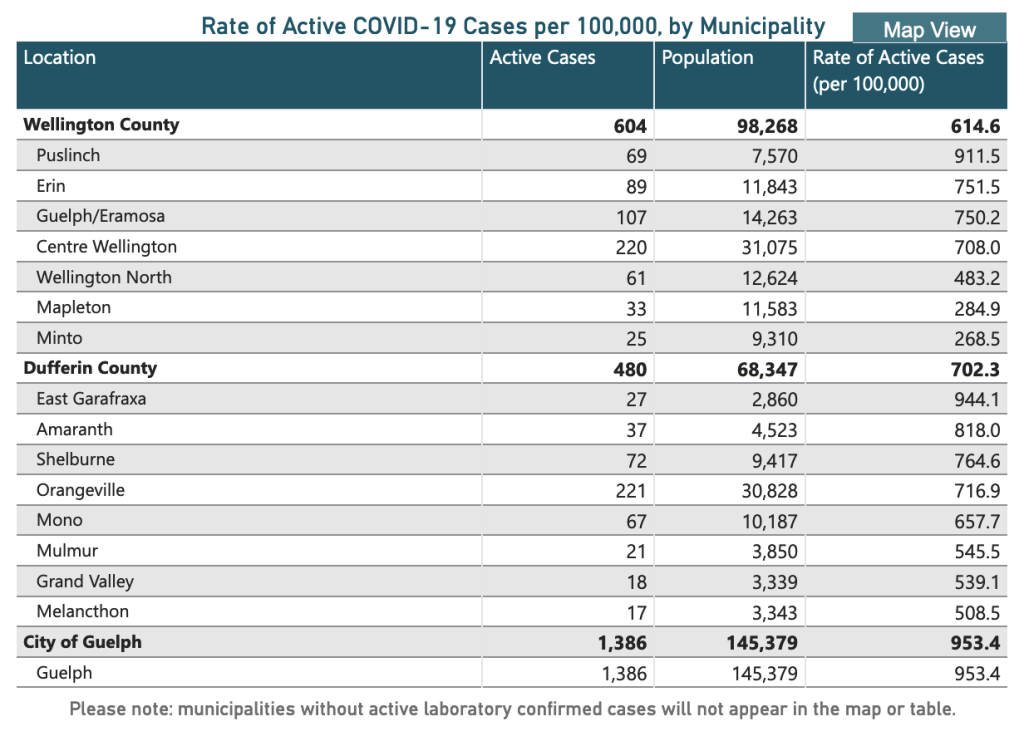WELLINGTON COUNTY – Wellington-Dufferin-Guelph Public Health (WDGPH) has reported 1,481 new COVID-19 cases during the first weekend of the new year.
As of Jan. 4, active cases across the health unit have risen to a new record-high of 2,593.
Following a decline in cases — to 29 on Nov. 2 — the region has witnessed an aggressive resurgence of the coronavirus, which officials attribute to the highly virulent Omicron variant.
The case rate per 100,000 population has increased from 366 to 725.3 in just over a week (Dec. 26 to Jan. 4).
And rate of COVID-19 tests returning positive for the virus also continues to balloon, from 15.1% on Christmas Eve to 32.1% as of Dec. 31.
The region’s effective reproduction number, used to measure how many additional cases spread or result from a single case, sat at 1.14 as of Jan. 2. A value of one or above means cases will increase; below one and spread will eventually cease.
The number of people hospitalized with COVID-19 in the region has remained steady since Dec. 23 at 13, of which four are in an ICU, as of Dec. 29. Vaccination status of those hospitalized are not disclosed locally.
According to provincial data, there are 389 unvaccinated persons hospitalized with COVID-19 across the province, of which 86 are in an ICU, as of the afternoon of Jan. 4.
Two-dose vaccinated individuals have surpassed the number of unvaccinated persons hospitalized, as of Jan. 4, accounting for 721 total hospitalizations across the province, with 54 of those persons in an ICU.
Considering about 82% of eligible Ontarians are vaccinated with at least two doses, data from the Ontario Science Table indicates that as of Jan. 3, unvaccinated individuals are six times more likely to be hospitalized with COVID-19 and 21 times more likely to end up in an ICU than those who are vaccinated.
Omicron variant breakdown
WDGPH identified the region’s first case of the COVID-19 Omicron variant on Dec. 9 in a fully-vaccinated Guelph male aged 12 to 20.
According to Public Health Ontario (PHO) data, as of Dec. 29, there have been 574 Omicron cases identified by either “complete genomic analysis” or “S-gene target failure” in the health region.
The S-gene target failure test looks for the absence of certain amino acids in a method known as “spike gene target failure,” because nearly all of the mutated COVID-19 Omicron specimens processed by labs as of Dec. 6 had revealed deletions of of amino acids at positions H69 and V70 within the spike protein.
Half of the test specimens found with those missing amino acids are being sent for whole genome sequencing, depending on the viral load of the test specimen, as of Dec. 7.
PHO cautions case counts are an “underestimate of the true number of individuals with COVID-19” in the province due to recent changes narrowing testing eligibility to only high-risk individuals who are symptomatic and/or are at risk of severe illness from COVID-19, meaning not all positive cases are known to health officials.
In recent weeks Ontarians have also reported difficulty in accessing both rapid antigen and PCR testing.
WDGPH estimates Omicron represents 5.4% of all COVID-19 cases between Dec. 26 and Jan. 1 in the health region.
Local trends
Wellington County had 355 newly-confirmed cases over the Dec. 31 to Jan. 3 reporting period, bringing the total active cases to 604 in the county as of Jan. 4.
That is the highest total yet for active cases in Wellington County. The record during previous waves of the pandemic was 122, set on April 19.
There are 1,386 active cases in Guelph and 480 in Dufferin County as of Jan. 4.
A new COVID-related death has been reported by the health unit.
According to WDGPH spokesperson Danny Williamson, a Wellington County man in his 80s died while infected with the coronavirus, increasing the death toll to 129 people, including 39 from the county.

Municipality-specific active COVID-19 case counts as of Jan. 4, 2022. (WDGPH image)
Vaccinations
Since Dec. 28, another 955 people have become two-dose vaccinated in the WDGPH region, bringing the total as of Jan. 4 to 242,516 or 82.2% of the population aged five or older.
There are 16,857 people aged five or older in the region who have received a first dose, as of Jan. 4.
According to Ontario’s COVID-19 Advisory Science Table data, as of Jan. 3, there were 1,526 new cases every day per million people in those unvaccinated, and 1,336 cases per day in those with at least two doses.
The data concludes there’s a 12.4% reduction in the risk of contracting a case with two vaccine doses. The reduction in the risk of being hospitalized with two doses is 83%.
In Wellington County 81.2% of eligible residents, including those aged five to 11, are two-dose vaccinated as of Jan. 4.
Less than 70% of residents in Mapleton are vaccinated, and it remains the only municipality within the county below that threshold.
Across the region, according to WDGPH data, there are an estimated 11,446 high school students who are vaccinated with two doses; 289 with only a single dose; and 2,023 students who have not yet received a single dose.
In elementary schools in the WDGPH catchment area, there are an estimated 30,034 students who are now eligible for vaccination, according to WDGPH data.
Of that group, 16,789 elementary students are at least vaccinated with a single dose as of Jan. 4. From that group, there are an estimated 5,736 elementary students who are fully vaccinated.
The remaining 13,245 students have not yet received a single dose.
Outbreaks
As of Jan. 4, outbreaks of COVID-19 have been declared in nine long-term care and two hospital settings throughout the WDGPH region.
A previously declared outbreak at Greystones Restaurant and Lounge in Orangeville on Dec. 20 remains active.




